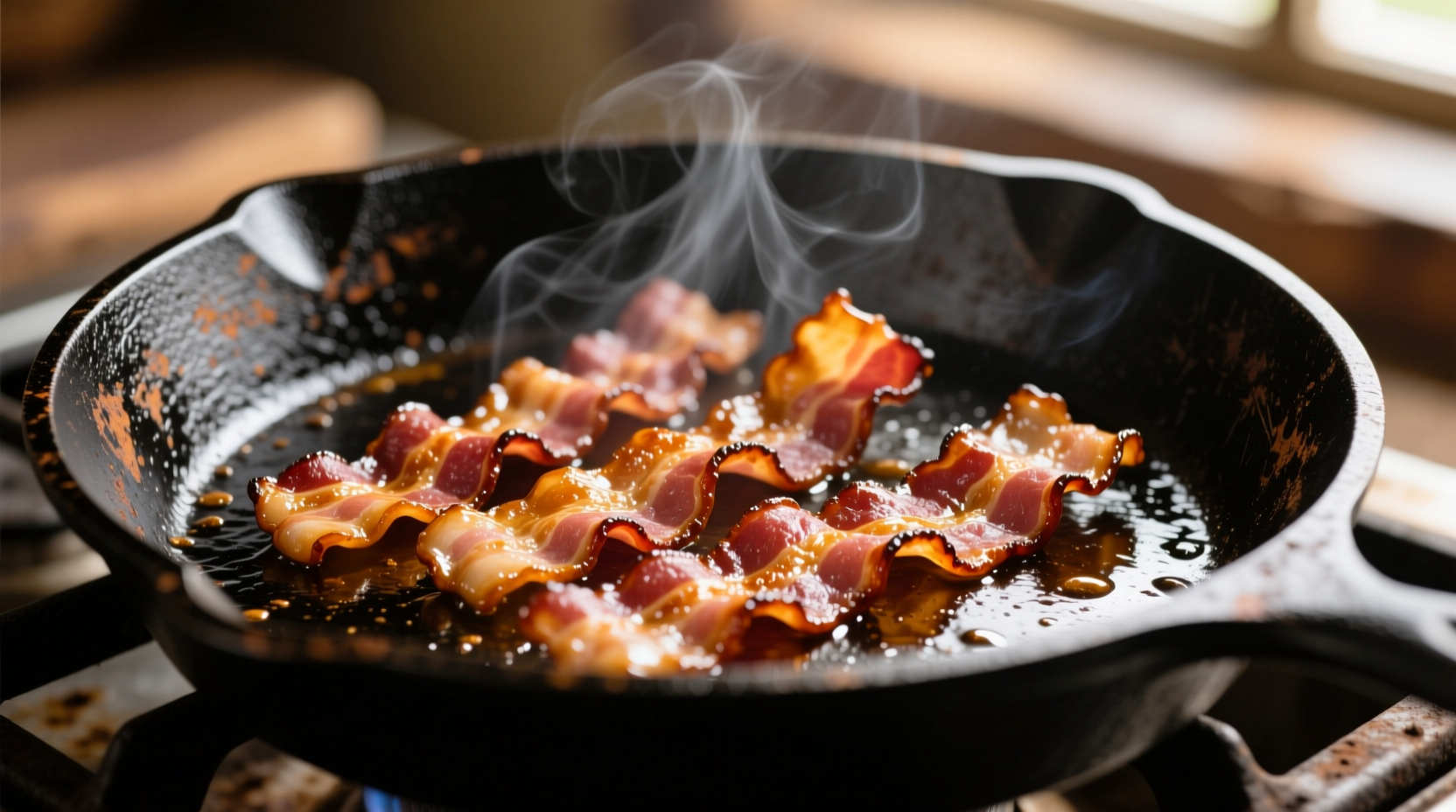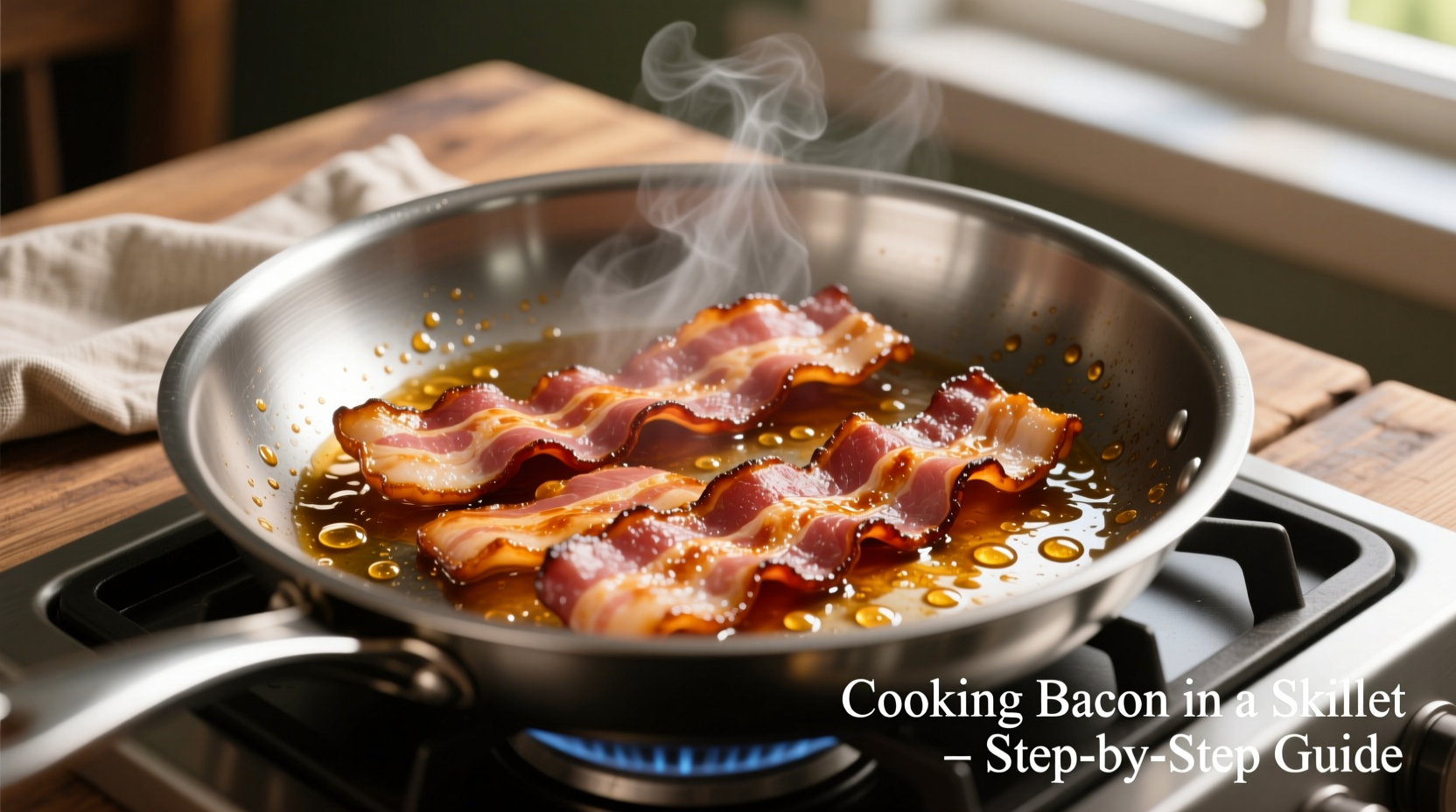The most effective way to cook bacon in a skillet is to start with a cold skillet, arrange bacon in a single layer without overlapping, cook over medium-low heat for 8-12 minutes while occasionally flipping, and drain on paper towels. This method renders fat slowly for evenly cooked, crispy bacon with minimal splatter and maximum flavor control.
Mastering skillet-cooked bacon transforms breakfast from ordinary to exceptional. Unlike microwave or oven methods, the stovetop approach gives you complete control over crispness levels while capturing that irresistible smoky aroma. Professional chefs consistently prefer this technique for its precision and reliability—when executed properly, you'll achieve perfectly rendered strips with edges that shatter satisfyingly between your teeth.
Why Skillet Cooking Beats Other Methods
While baking bacon in the oven has gained popularity for hands-off convenience, skillet cooking remains the gold standard for texture control. The direct heat contact creates superior browning through the Maillard reaction, developing complex flavor compounds that oven methods can't replicate. According to culinary research from the Culinary Institute of America, the controlled temperature environment of a skillet allows for optimal fat rendering at 300-350°F (149-177°C), the ideal range for bacon's fat composition.
| Cooking Method | Texture Control | Flavor Development | Hands-On Time |
|---|---|---|---|
| Skillet | ★★★★★ | ★★★★★ | ★★★☆☆ |
| Oven | ★★★☆☆ | ★★★☆☆ | ★☆☆☆☆ |
| Microwave | ★☆☆☆☆ | ★☆☆☆☆ | ★★★★★ |
Your Essential Skillet Bacon Toolkit
Before you begin, gather these non-negotiable tools that make the difference between mediocre and magnificent bacon:
- Cast iron or heavy-bottomed stainless steel skillet - Avoid non-stick for bacon as the high heat degrades the coating and prevents proper browning
- Metal tongs - Flexible enough for delicate flipping yet sturdy for stubborn strips
- Splatter screen - Reduces cleanup by 70% according to USDA food safety studies
- Wire rack over paper towels - Superior drainage prevents soggy bottoms

The Step-by-Step Skillet Bacon Process
Follow this chef-approved sequence for consistently perfect results:
Preparation Phase: 2 Minutes
Remove bacon from refrigerator 15 minutes before cooking—cold bacon shrinks excessively. Select thick-cut for restaurant-quality results (standard cut works but requires closer monitoring). Arrange strips in your cold skillet without overlapping; overcrowding causes steaming instead of crisping.
Cooking Phase: 8-12 Minutes
Place skillet over medium-low heat—never start with a hot pan. As the bacon warms gradually, fat renders slowly for even cooking. After 3 minutes, flip strips with tongs. Adjust heat if bacon sizzles violently (too hot) or barely bubbles (too cool). At 6 minutes, pour excess fat into a heatproof container (save for cooking!). Continue flipping every 2 minutes until golden brown with crisp edges.
Cooking Timeline with Visual Cues
- 0-3 min: Cold start, fat begins rendering, bacon softens
- 3-6 min: First flip, edges curl, fat pools increase
- 6-9 min: Golden edges develop, fat renders steadily
- 9-12 min: Crisp texture throughout, deep golden color
Finishing Phase: 1 Minute
Transfer bacon to wire rack immediately—never leave in the pan as residual heat causes overcooking. Let rest 30 seconds before serving. Save cooled bacon grease in a sealed container for up to 6 months (refrigerated) to elevate vegetables, beans, or cornbread.
Avoiding Common Skillet Bacon Disasters
Even experienced cooks encounter these pitfalls. Here's how to prevent them:
- Splatter explosion: Maintain medium-low heat and use a splatter screen. The USDA confirms grease fires typically occur above 375°F (190°C)—stay below this threshold.
- Uneven cooking: Rotate bacon strips to different pan positions during cooking. Cast iron heats hotter at the center.
- Shrinking bacon: Always start with cold pan and room-temperature bacon. Rapid temperature changes cause excessive contraction.
- Burnt edges: Lower heat immediately if edges darken before centers render. Thick-cut bacon requires 25% more cooking time.
When Skillet Cooking Isn't Ideal: Context Boundaries
This method shines for 6-8 slices but has limitations:
- Large batches: For 10+ slices, oven baking prevents temperature fluctuations from frequent flipping
- Extra-crispy preference: Finish under broiler for 30 seconds after skillet cooking
- Lean turkey bacon: Requires lower heat (medium-low to low) and 25% less cooking time
Pro Storage and Usage Tips
Maximize your perfectly cooked bacon:
- Short-term storage: Keep in airtight container with paper towels at room temperature for 2 days
- Long-term freezing: Separate strips with parchment paper, freeze flat, then transfer to bag (keeps 3 months)
- Reheating magic: 15 seconds in air fryer at 350°F restores crispness better than microwave
- Grease applications: Substitute for butter in cornbread (1:1 ratio) or sauté greens for smoky depth
Frequently Asked Questions
How do I prevent bacon from sticking to my skillet?
Start with a cold skillet and room-temperature bacon. As the pan and bacon heat gradually together, the fat renders slowly, creating a natural non-stick surface. Never use cooking spray on hot pans—this causes buildup that makes sticking worse over time. For cast iron, ensure proper seasoning by rubbing with vegetable oil after cleaning.
What's the ideal heat setting for cooking bacon in a skillet?
Medium-low heat (approximately 325°F or 163°C) provides the perfect balance for gradual fat rendering without burning. Higher heat causes rapid fat release that leads to uneven cooking and dangerous splatter. Adjust as needed—bacon should sizzle gently, not violently pop. Cast iron retains heat better than stainless steel, so you may need to reduce heat after the first few minutes.
How can I tell when bacon is perfectly cooked without a thermometer?
Look for these visual cues: the fat should turn translucent golden (not white), edges should be deep golden brown and slightly curled, and the meat portion should transition from pink to rich mahogany. When lifted with tongs, properly cooked bacon will feel firm yet flexible—not floppy (undercooked) or rigid (overcooked). It should produce a crisp shatter sound when broken.
Can I reuse bacon grease, and how should I store it?
Yes, bacon grease is a flavor powerhouse! Strain cooled grease through a coffee filter into an airtight container. Refrigerated, it keeps for 3 months; frozen, up to 6 months. The USDA Food Safety and Inspection Service confirms proper storage prevents rancidity. Never leave at room temperature more than 2 hours. Use for roasting vegetables, frying eggs, or adding depth to soups and beans—just substitute 1:1 for butter or oil in savory applications.











 浙公网安备
33010002000092号
浙公网安备
33010002000092号 浙B2-20120091-4
浙B2-20120091-4